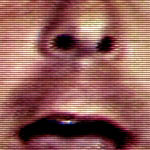 I’m distracted. I look up from the doodle on my post-it notepad and see the department manager, stem to torso, standing at his desk. I haven’t gotten used to it even though it’s been two weeks since he first decided to start standing. Let me be clear on this point: he no longer sits. Ever. His laptop rests atop a tower of stacked monitor stands, and an attached keyboard is placed such that his arms can reach it from a neutral position. It’s like he’s become an upright fundamentalist. I don’t think he has a chair in his office anymore, and even the family photos on his desk that depicted people sitting were removed by the custodial staff. At first I assumed that this elevated stature was designed to give him a crow’s nest vantage point over the cubicle farm, but now I remember the mean ergonomics lady.
I’m distracted. I look up from the doodle on my post-it notepad and see the department manager, stem to torso, standing at his desk. I haven’t gotten used to it even though it’s been two weeks since he first decided to start standing. Let me be clear on this point: he no longer sits. Ever. His laptop rests atop a tower of stacked monitor stands, and an attached keyboard is placed such that his arms can reach it from a neutral position. It’s like he’s become an upright fundamentalist. I don’t think he has a chair in his office anymore, and even the family photos on his desk that depicted people sitting were removed by the custodial staff. At first I assumed that this elevated stature was designed to give him a crow’s nest vantage point over the cubicle farm, but now I remember the mean ergonomics lady.
She is responsible for this, I’m sure of it. Last month she made her presence known to the entire staff, flitting from cube to cube, making notes, and offering each of us cold reads on the spot. “I’m going to have you move your armrests down,” she said. And people complied because they assumed she had complete armrest authority. She could hear carpal tendons from across the room, inflamed and rubbing together like frayed ropes. “We don’t want to hold our wrists up like that for an extended period of time,” she said. And, “Let’s go ahead and increase our monitor’s refresh rate so that we can avoid seizures.” And, “Do you have scoliosis, or are you just broken?”
Ergonomically-speaking, I wanted to urge her to relax as she plummeted from our sixth story window, but pity cooled my coals. Her task, after all, was unenviable. The implicit question is: how can humans survive in an office environment for an extended period of time without physical trauma? Personally, I would answer that succinctly by pulling out my urine-stained performance review and weeping. Point made.
It’s not my office manager alone who is responsible for my distraction, but rather the altered environment ergonomics lady left in her wake. Strange things are afoot, and it’s proven detrimental to my performance. Late last week I attended an in-house training class, and our instructors, three women from the HR team, conducted the entire class in a fetal position, lying on gel-filled mats, and navigating through their PowerPoint decks using sip/puff tubes. They certainly seemed comfortable–one of them even fell asleep during the course, and we had to reconvene after lunch.
Were these the lengths to which people would go to reduce the stress of the oppressive confines of their corporate veal cages, without actually escaping them? Why draw the line at the cubicle then? Why not just stay home instead? It’s the interstitial area between fight and flight, a state of mind that is accessible only to those who medicate to toleration. But the real truth, I fear, lies within a cylindrical glass tank.
Deep in the bowels of the building where I work there is a vaulted chamber, thrumming like a secret heart. In its wanly lit atrium the members of the Executive Committee perform their unholy congress cloaked in Brooks Brothers and DKNY. These are the minions of our CEO, who has lately taken to floating suspended in his tank full of burbling amniotic fluid. From this ergonomic utopia he directs the business, communicating his directives through a subdermal microphone.
At our company’s all-hands meeting we gather, all of us, around the CEO’s tank like pigeons around the breadcrumb lady on her park bench. As they massage their palsied wrists, I see fear and admiration both on my coworkers’ faces. When the CEO addresses us, we are expecting to hear wisdom of unmatched depth, but, as incongruous as it would seem, the meeting is actually boring: market-spew and revenue stats, and other obscure information best experienced as background noise. Right up until the very end, that is.
“The last order of business,” he says, “concerns your participation within this organization.” We look at each other as he pauses, drawing the moment out. Then he tells us that we are each, in turn, to have a hand in transferring him from the lymphy broth of the tank to his sensory deprivation chamber. At the end of each workday we will sponge him off, and pat him dry. We will powder his cherub skin, swathe him in a silk tunic, and slide him into his live-work womb. There is some consternation among the ranks, and I hear one of the Marketing reps asking her neighbor whether such a burden might not exacerbate the nerve damage in her forearms.
But the CEO is not finished, and the look on his face has transformed. He places a palm up to the glass membrane and says, “Though life is but the setup to death’s punchline…. Friends, shareholders, it is too late for me. If I could weep still…” he swirls his arms at his sides like propellers. “This life-restoring soup may as well be my tears. But I can see now that I’ve gone too far. I know that. And it happened, all of this, because I lost sight of the truth. But there is hope for you. The truth is that carpal tunnel syndrome and a numb ass are the modern office’s gift to you! What could be more life-affirming than fluorescent headaches and mouse-finger calluses? Please… try to see these things for what they are. They are reminders… that we are alive–truly alive!” His hands are both on the cylinder wall now, and the plea has brought life to his eyes again, if only for a moment. “Now back to your desks,” he says.
Work hurts.
 I used to pretend that my pencil was a rocket. As my Grade 3 teacher broke the world into morsels digestible to eight year olds, I was launching golden missiles into space. I would squint with one eye open and, holding my Ticonderoga by the metal band around the eraser, move it steadily upward into my field of vision. Then, once the lead tip (or “nose cone”) had ascended out of view, I would deftly switch hands, grabbing the tip in my other hand while releasing the engine in time to see it sweep seamlessly by. Persistence of vision provided the illusion of unassisted flight across a constellation of adolescent heads. This business was hardly subtle, and on more than one occasion I was spotted by the teacher, my attention compromised, and made to participate in undesirable activities.
I used to pretend that my pencil was a rocket. As my Grade 3 teacher broke the world into morsels digestible to eight year olds, I was launching golden missiles into space. I would squint with one eye open and, holding my Ticonderoga by the metal band around the eraser, move it steadily upward into my field of vision. Then, once the lead tip (or “nose cone”) had ascended out of view, I would deftly switch hands, grabbing the tip in my other hand while releasing the engine in time to see it sweep seamlessly by. Persistence of vision provided the illusion of unassisted flight across a constellation of adolescent heads. This business was hardly subtle, and on more than one occasion I was spotted by the teacher, my attention compromised, and made to participate in undesirable activities. I’ve come to understand that, in most cases, there is just one thing that is supposed to hold our attention. It’s usually the most obvious thing, and far more clever folk refer to it as “the thing right in front of you,” or “the task at hand.” Yet it could be anything. Whether we’re clipping off body parts and storing them in freezer bags, or filling our tax forms with bizarre scribbled figures, we know where our focus is supposed to be.
I’ve come to understand that, in most cases, there is just one thing that is supposed to hold our attention. It’s usually the most obvious thing, and far more clever folk refer to it as “the thing right in front of you,” or “the task at hand.” Yet it could be anything. Whether we’re clipping off body parts and storing them in freezer bags, or filling our tax forms with bizarre scribbled figures, we know where our focus is supposed to be. All this shuffling going on, and suddenly the barking guy is back. I remember the barking guy from a long time ago when he used to sit in my unit (“the ward”), and now the churn has popped him back up like a shell in the surf. This is the guy who spoke in short, staccato bursts, always peppering his Tourette cadence with authoritarian hand-chopping gestures. His manner to coworkers was always immaculately perfunctory, so he became an easy villain in the dramatic construct I fancied myself a player in. Of course I’m no protagonist–I’ve never been anything more than a background character in my own fantasies–but I’m certainly qualified to make such judgments about others.
All this shuffling going on, and suddenly the barking guy is back. I remember the barking guy from a long time ago when he used to sit in my unit (“the ward”), and now the churn has popped him back up like a shell in the surf. This is the guy who spoke in short, staccato bursts, always peppering his Tourette cadence with authoritarian hand-chopping gestures. His manner to coworkers was always immaculately perfunctory, so he became an easy villain in the dramatic construct I fancied myself a player in. Of course I’m no protagonist–I’ve never been anything more than a background character in my own fantasies–but I’m certainly qualified to make such judgments about others. All around me, decay. Even renewal is part of the decay, because it is part of a continuum I view through clouded lenses, and perceive with synapses beset by atrophy. So it is that I grew tired of playing the portrait to my operating system’s Dorian Gray.
All around me, decay. Even renewal is part of the decay, because it is part of a continuum I view through clouded lenses, and perceive with synapses beset by atrophy. So it is that I grew tired of playing the portrait to my operating system’s Dorian Gray.